Ladakh 2017 Trip Report: Searching for Snow Leopards
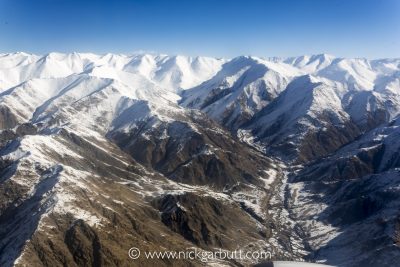
Typical snow leopard terrain in Ladakh
Back in 2006 the BBC broadcast the first series of Planet Earth. It was a landmark production, five years in the making and at the time, the most expensive natural history documentary ever made. Arguably the stand out and most talked about sequence from the eleven episodes was of a snow leopard chasing a markhor (a type of wild goat) down a vertiginous rocky slope. This was filmed in Chitral Gol in Pakistan – not the easiest or safest of places to travel too.
In the intervening time since we first marveled at wild snow leopards on our TV screens, a handful of locations in the Himalayas have begun to reveal regular and increasingly reliable sightings of these cats and now offer the opportunity for those that are committed to try and see what must be the Holy Grail for anyone with a feline fetish.
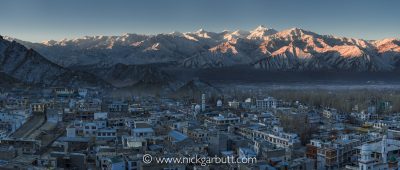
Dawn view of the Himalayas from Leh
It has been a life ambition of mine to see (and photograph) all the world’s species of big cats in the wild. I already have the relatively easy ones under my belt – tiger, lion, leopard, jaguar, cheetah and puma – so clapping eyes on a snow leopard would give me the full set.
Over two years ago I began planning with Wildlife Worldwide a first tour to Ladakh in northern India. Research had led me to believe some of the better-known and more popular locations suffered from various short-comings that might compromise the overall experience, so I turned my attentions to locations with a lower profile.
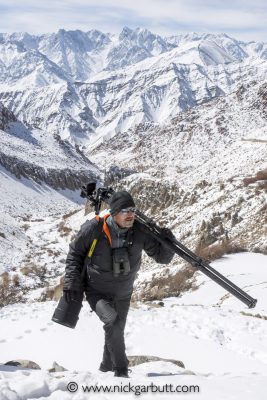
Páramo clothing kept me warm, while an RRS tripod and gimbal head were ideal for supporting my 600mm f4 lens
![]() In anticipation of this first trip one of the first decisions I made was to trade in my Nikon 500mm f4 for the 600mm equivalent. This had consequences, as the 600mm weighs over 1100 grams more. My trusty Really Right Stuff tripod was still plenty beefy enough, but I soon found the RRS ball head could at times be a little awkward. It was plenty strong enough to hold the weight of the lens/ camera combination, but I found so much extra care was needed to keep control of the lens when trying to follow moving subjects. The perfect solution was the new RRS fluid full gimbal head.
In anticipation of this first trip one of the first decisions I made was to trade in my Nikon 500mm f4 for the 600mm equivalent. This had consequences, as the 600mm weighs over 1100 grams more. My trusty Really Right Stuff tripod was still plenty beefy enough, but I soon found the RRS ball head could at times be a little awkward. It was plenty strong enough to hold the weight of the lens/ camera combination, but I found so much extra care was needed to keep control of the lens when trying to follow moving subjects. The perfect solution was the new RRS fluid full gimbal head.
Winter is the best time to try and see snow leopards as the harsh weather forces their main prey - grazing and browsing animals like Asiatic Ibex, Urial and Bharal (both types of wild sheep) to lower altitudes.
![]() Being well prepared is obviously essential, especially with the prospect of spending long periods outside in freezing temperatures at higher altitudes. Knowing conditions would be harsh and potentially changeable and likely to range from high winds and blizzards to intense sunshine, I knew good insulation, layering and flexibility would be crucial, so I chose a selection of Páramo gear* to protect me from the elements.
Being well prepared is obviously essential, especially with the prospect of spending long periods outside in freezing temperatures at higher altitudes. Knowing conditions would be harsh and potentially changeable and likely to range from high winds and blizzards to intense sunshine, I knew good insulation, layering and flexibility would be crucial, so I chose a selection of Páramo gear* to protect me from the elements.
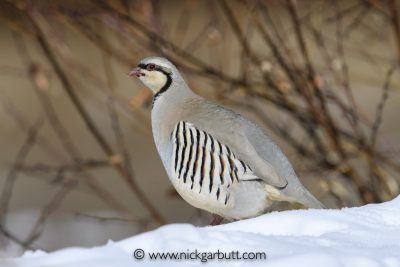
Chukar Partridge are common
In February this year (2017) I set off with a group for the first time in search of snow leopards in Ladakh. The following is a succinct account of what turned out to be one of the most exciting and memorable trips I have enjoyed anywhere in the world.
After overnighting in Delhi, we flew to Leh, the capital of the ancient Himalayan kingdom of Ladakh (now part of Jammu and Kashmir). The descent from the clouds was spectacular, the plane first passing over and then weaving between towering snow-covered mountains before landing on seemingly the only fat area in the Indus Valley. There was a sharp intake of breath on stepping out into the crisp mountain air.
The obvious urge is to let enthusiasm and impatience takeover and head strait off to the snow leopard areas. This would be very unwise and such impulses should to be resisted. Firstly, for safety reasons because it takes time to acclimatise to the thin air - Leh is around 3500m (11,500 ft) asl - and secondly, because Leh is a fascinating place and warrants time exploring its labyrinth of old streets, markets and the ancient royal palace.
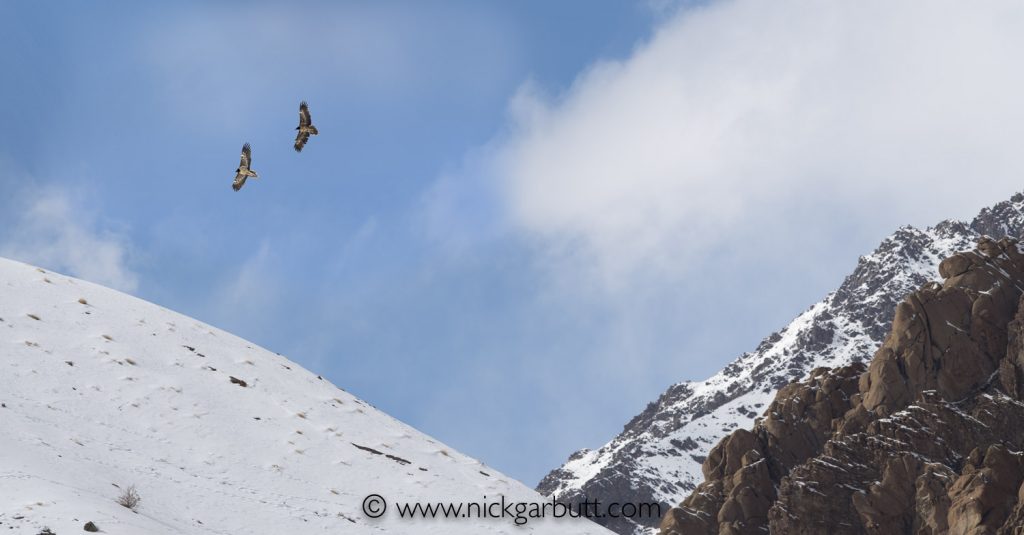
Lammergeier are birds that define rugged mountainous terrain and are frequently encounted
We stayed in Leh for three nights, which gave us the chance to explore. On the first day we drove southeast, along the Indus Valley, paralleling the river for around 50km. The drive inevitably took us through wonderful mountain scenery, with impressive geological features very much in evidence. This part of the Indus Valley is thought to be the area of first contact where the Indian and Asian tectonic plates collided some 50 million years ago, causing colossal upheaval and folding of the rocks and ultimately creating the Himalayas. These forces are still at work today, incrementally pushing the mountains higher. The Himalayas are still growing.
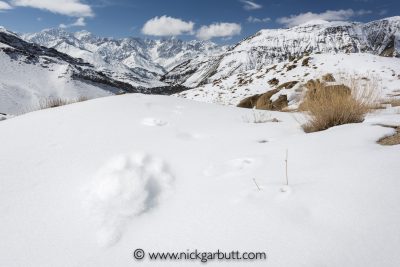
Snow Leopard pug marks in fresh snow
On some of the high scree slopes we saw small groups of Bharal or Blue Sheep moving and grazing on the meager pickings of vegetation. There were also small flocks of both Chukar and Tibetan Partridge feeding in fields adjacent to villages and high over the ridges the occasional Golden Eagle and Lammergeier was seen.
Our second day was spent exploring Leh: this included a visit to the ancient Royal Palace and spending time with the Snow Leopard Conservancy, where the director, Tsewang Namgail, gave a fascinating informal talk about the work of the trust in Ladakh and the issues surrounding snow leopard conservation.
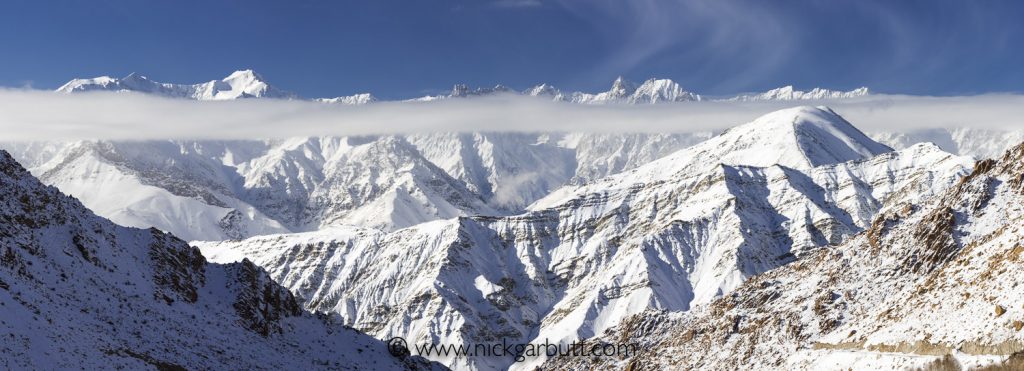
The spectacular valley in which we would concentrate our efforts to find Snow Leopards
The following day we travelled on to the Zanskar Range of the Himalayas that lie to the west of Leh. The route again followed the course of the Indus, with imposing ranges of mountains either side of the river, before we turned away from the river and headed deeper into the mountains. The road narrowed to a winding single track: as we climbed higher it was apparent there had been heavy snowfall, as many of the slopes were covered in a thick blanket. Our base at the head of a secluded valley lay at around 4100m (13,500ft). Here, with the help of trackers from the Snow Leopard Conservancy we would look for the cats and other wildlife for nine days. The view from our homestay was breathtaking: looking down the steep-sided valley to the receding rows of rugged mountains that form the Zanskar ranges.
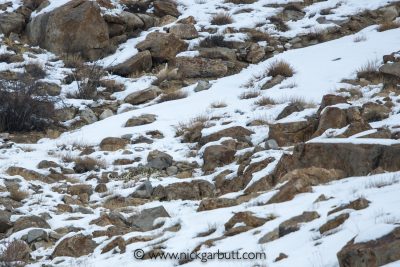
Our first meaningful sighting of a Snow Leopard: the cats' camouflage is exquisite
Over the course of our stay, long periods were spent each day scanning the high slopes on either side of the valley with telescopes. Our three guides had remarkable vision and their unaided eyes picked out the movement of ibex and other species on steep snowy cliffs several hundred meters away, were as we often struggled to see the same things with binoculars.
Around the homestay there was plenty of bird activity, with species like Eurasian Magpie, Chukar Partidge, Red-billed Chough, Alpine Chough, Robin Accentor and Güldenstädt's or White-winged Redstart seen on a daily basis.
The first snow leopard sighting came on day three. Our guides had taken us part way up a neighbouring valley to a point where two branches of the upper valley and the surrounding peaks were visible. After several hours of looking and waiting, one of the guides spotted movement on a distant peak. It turned out to be so distant that we all struggled to see the animal even through a telescope, let alone take a meaningful photo.
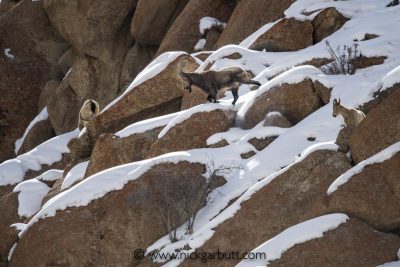
Asiatic Ibex climbing on a steep rocky slope
The next opportunity came two days later. I went out before dawn into the freezing air to set up a time-lapse sequence of the sunrise on the mountains. An hour and a half later, around 7.30am I returned to collect my camera, and suddenly heard the unmistakable call of a snow leopard – a deep guttural meow – coming from high on the ridge to my right. I rushed back to the homestay to find the guides already onto it, tracking the cats’ movements along the ridgeline. Everyone else scrambled on their warm clothing and spilled outside. We clustered around the guides and our telescopes desperate to see the cat for ourselves.
The snow leopard was again quite far away, but gradually it moved a little closer and we were able to take some record shots that at least clearly, but distantly, showed the animal moving across a snowy slope. Then we saw a second cat and the pair moved further along the ridge together: February and March is mating time and this was almost certainly a courting pair, hence the distinctive calls heard earlier.
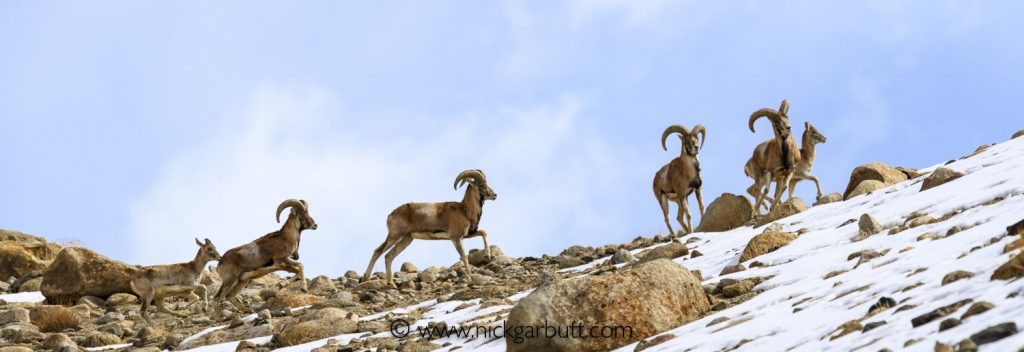
A group of fleet-footed Urial move across a rocky slope
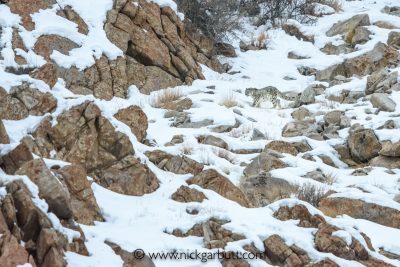
A male Snow Leopard negotiates a boulder strewn slope
The following days were spent searching the same or similar areas again, as well as looking at alternative locations. There were excellent sighting of wild wolves and urial, the characteristic wild sheep of the area and another species widely preyed upon by snow leopards.
What turned out to be our final opportunity with snow leopards came a further three days later: in the afternoon the guides took us higher up the valley to a vantage point where ridges on both sides were visible. Earlier in the day they had found pug marks (foot prints) – almost certainly of the courting pair – and they were confident the cats were still somewhere at the head of the valley.
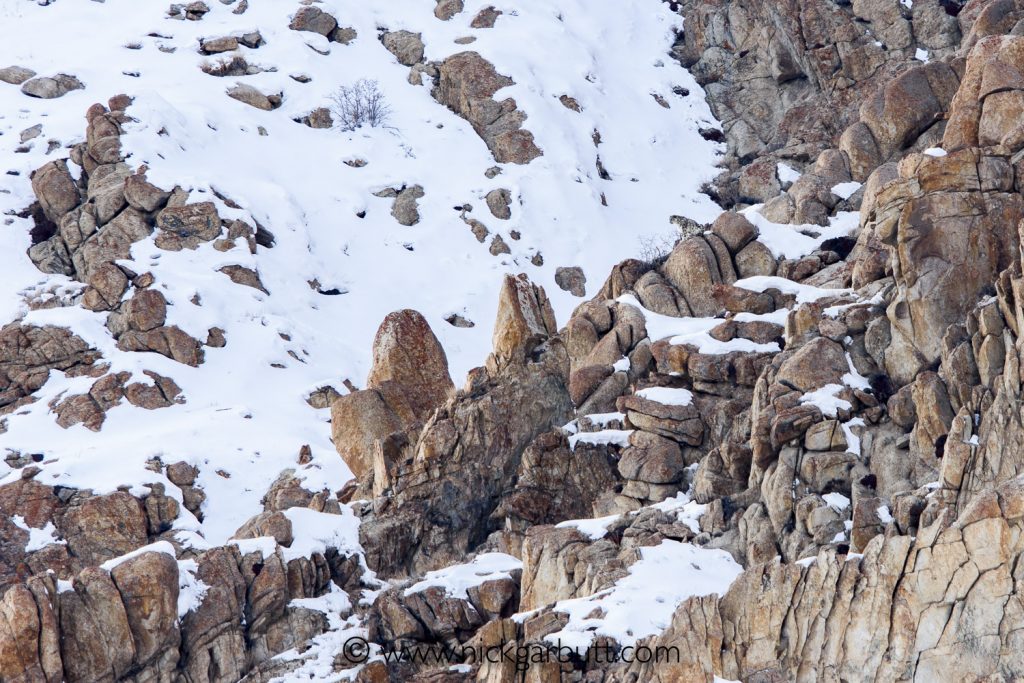
My insurance shot: a male Snow Leopard taken from across the valley
After two hours of combing the slopes using telescopes there were no apparent signs. Undeterred the guides continued their searching and once again began looking closely at the slopes slightly lower down the valley. Ten minutes later they found a snow leopard - probably the male, sitting on a prominent rock overlooking the valley on the opposite side from our position. The guides knew straight away, our best chance of getting closer for photos was to descend back down the valley to an alternative position in anticipation of where the cat was likely to move. I took a couple of distant shots for insurance.

A courting pair of Snow Leopards play hide-and-seek on the ridge line
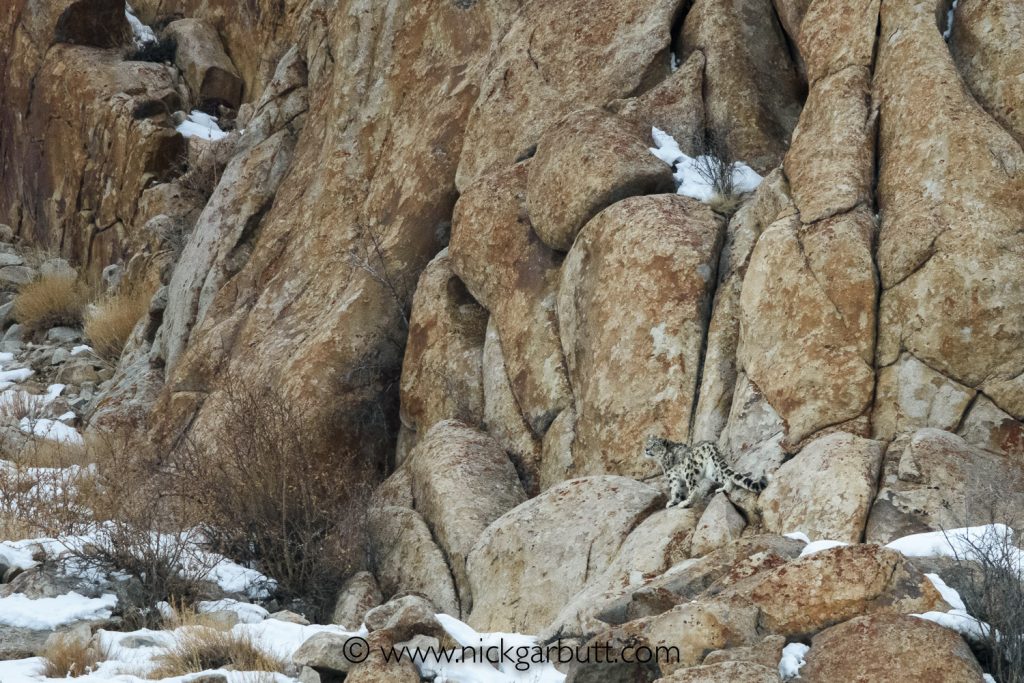
A male Snow Leopard surveys the terrain
By the time we were back in position lower down, there were two snow leopards visible – the pair were back together and seemed to be playing a game of hide-and-seek amongst the rocks on the ridge. Then the female moved off and disappeared and the male sat for a while looking over the valley. He then climbed down and began descending the slope roughly in a direction towards me. As he picked his way through the boulders and snowy patches it was so difficult to keep track, as his camouflage was so good. Once I had found in the viewfinder, I was terrified of taking my eye away from the camera, as I knew it would then be almost impossible to locate him again. The smooth balanced movement of my 600mm, 1.4x converter combination on the RRS gimbal head undoubtedly helped hugely here – without it, I doubt I’d have been able to keep the animal within my sights.
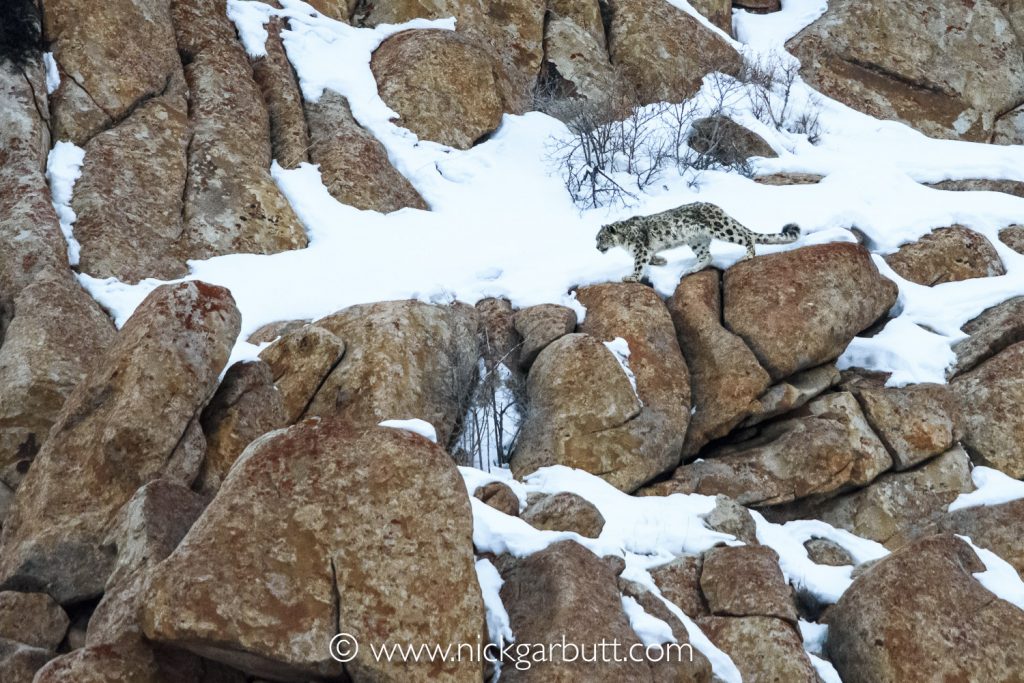
A male Snow Leopard tracks across the snowy slope
I was now frantically rattling off volleys of shots as the snow leopard moved further across the rocky slope. Dusk was descending fast, light levels were dropping and the temperature was plummeting, but hands that had been cold and numb ten minutes earlier were now glowing with the heat of action. The snow leopard came within perhaps 500m, and then traversed the slope before climbing higher onto another ridge. In the half-light of dusk the last we saw of him was a silhouette on the skyline before he disappeared over the other side.
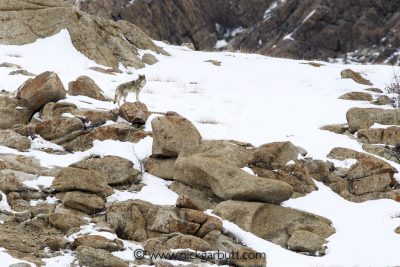
Wolves are another top predator seen in the area
That final hour had been an intense bout of concentration and excitement, with adrenaline coursing my blood. In such instances, I never feel more alive and the feeling is as addictive as any drug. Which is exactly why I intend returning for more.
Nick Garbutt and Wildlife Worldwide will again be running snow leopard trips to Ladakh in 2018 and 2019.
* I packed the following Páramo clothing for the trip
 Bentu fleece
Bentu fleece
Torres Alturo jacket
Torres Medio gilet
Cascada II trousers
Quito trousers
Grid long johns
